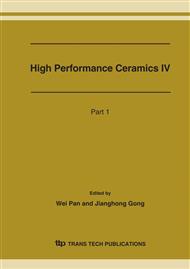p.1699
p.1703
p.1707
p.1711
p.1715
p.1718
p.1722
p.1725
p.1728
Microstructure and In Vitro Bioactivities of HA/Ti Composites Prepared by Hot Isostatic Pressing
Abstract:
Hydroxyapatite (HA)/titanium (Ti) composites were successfully fabricated by hot isostatic pressing at 850°C. The microstructure of 7T2HB (70Ti+20HA+10Bioglass, Vol. %) composites were systematically investigated. The main constituents of the composites are hydroxyapatite and titanium. A simulated body fluid (SBF) with the same ion concentrations as those of human plasma and pH value of 7.4 is selected to evaluate the in vitro biological properties of the composites. After 2-week immersion in SBF, the bioactive apatite formed a very dense film on the surface of the composites. The dissolution of CaO and Ca-P compounds in SBF improves the growth of apatite on the surface of the composites.
Info:
Periodical:
Pages:
1715-1717
Citation:
Online since:
April 2007
Authors:
Price:
Сopyright:
© 2007 Trans Tech Publications Ltd. All Rights Reserved
Share:
Citation:


